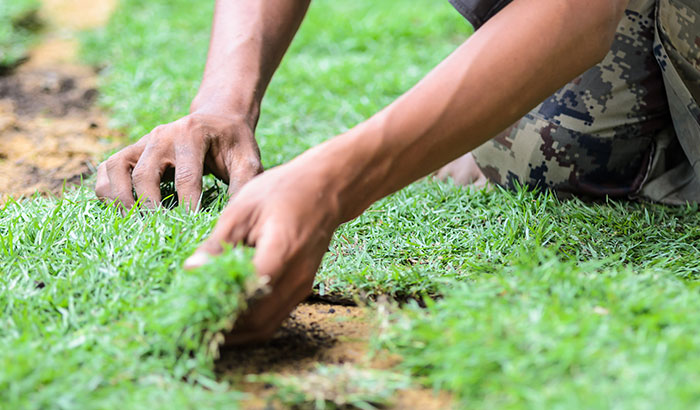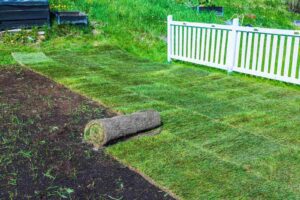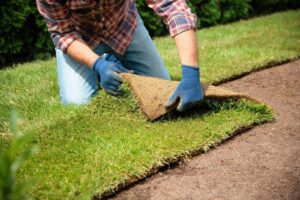Laying down sod might seem easy; however, there’s a lot to know about what to do and, more importantly, what not to do.
Are you wanting to get your lawn looking its best? Whether it’s a new lawn or one you are renovating, laying sod is one of the best ways to get the yard of your dreams. Lush, green grass is the goal, and sod is the answer. However, it’s essential to know that laying down sod requires careful attention, proper handling, and correct installation. A lot can go wrong.
Sod can come in large flat or rolled square or rectangular sections that must be installed appropriately to achieve the best results. Failure to do so could result in sod that doesn’t take or a yellow, dry lawn.
Continue reading to learn more about what not to do when laying down sod.
What Not to Do When Laying Sod
You might think you know how to lay sod; however, more goes into the project than just laying it down and calling it good. There’s a process that you should follow if you want to have your sod be successful. Today, we’re filling you in on everything you need to know about how to lay sod and what not to do when doing it:
- Don’t Schedule Your Sod Delivery Too Soon — Installing sod involves several steps. First, you’ll need to measure the area to determine precisely how much sod you need. Once you have that number, you can order the sod. Set the delivery time for when it’s convenient for you; pick a time when you can lay the sod.
It’s important to remember that sod is alive and has an expiration date once it’s cut and delivered. The thin layers of soil embedded in the grass can overheat, dry out, and even decompose. This means sod cannot be stored and should ideally be laid within 24 to 48 hours of delivery.
- Don’t Forget to Prep Your Yard — Yard prep is one of the most important steps of laying sod. To avoid waiting too long to lay your delivered sod, do the yard prep days before delivery. That way, you can install the sod as soon as the palettes arrive.
That said, it’s also important not to try and install sod over an area that hasn’t been prepped just to keep your sod slabs from dying. Sod isn’t likely to thrive or survive if you haven’t prepared the space for installation.
Prepping for sod includes removing all old grass, weeds, or other plants since sod cannot lay roots if they have to grow past existing plants. You’ll also want to gently loosen the soil and water it. Be careful not to overwater it, as that will muddy it.
Your prep work should also include grading the soil near curbs and sidewalks so that the sod doesn’t sit too high. This could result in the grass not getting enough water, getting scalped when mowed, and causing people to trip.
- Don’t Skip Fertilizing — A big part of yard preparation is testing your soil. These test results will tell you about your soil’s pH levels and what you need to do to grow grass successfully. Most people need to apply a starter fertilizer to the area, if not something more.
- Don’t Lay Your Sod Unevenly — Laying sod is much like a puzzle but almost as easy as unrolling a rug. Like puzzles, the pieces should line up just right. If there are gaps, you’ll have bald spots, and if the pieces overlap, you’ll end up with an uneven lawn.
Ideally, your sod pieces should be staggered to lay like bricks so that the ends closely touch but don’t overlap. This will create a much more attractive final pattern.
- Don’t Skip Rolling — Once your sod pieces are down, you should use a lawn roller to go over them. Forgetting this step could hinder the sod’s ability to root and result in uneven growth. Rolling your sod almost always ensures a good, even yard.
- Don’t Forget to Stay Off the Grass — Staying off newly sodded areas for two to three weeks is key. Avoiding using your lawn during this time will allow your sod to get a good establishment. This suggested prohibition includes keeping kids, animals, and huge dogs off the lawn, so the sod pieces stay even and level while they take root.
Moreover, it’s important not to mow too soon. Sod roots need to stay moist and need time to allow the roots to grow into the soil beneath them. Once your sod has had two or three weeks to adequately and properly root, you can mow your grass without the potential of damaging it!
- Don’t Forget to Water the Sod — While sod comes in pieces detached from the earth, it is essential to remember that it is still a living and breathing plant! Like other plants, the sod requires water to root and properly grow. Consistency and keeping your grass moist are key.
Start by heavily watering your sod on the first day. Then, during the first and second week, water two to four times during the day, ideally between 7 am and 2 pm. During the third week, you can water it once daily; during the fourth week, water it every other day. From there, water as needed per the weather in your area.
Let Monarch Sod Do the Job For You!
There are many things you shouldn’t do when it comes to laying down sod, but the best thing you could do is call the pros at Monarch Sod to do the job for you. Our skilled and trusted team knows all of the ins and outs of laying sod and is here to help you in your time of need. Our experienced and knowledgeable crew can help you achieve the lush and beautiful lawn of your dreams.
We are conveniently located in Lehi, Utah, and are ready to help the residents and business owners in the Salt Lake and Utah Valley area with all of your sod needs. Contact our team to learn more today!
toto slot











